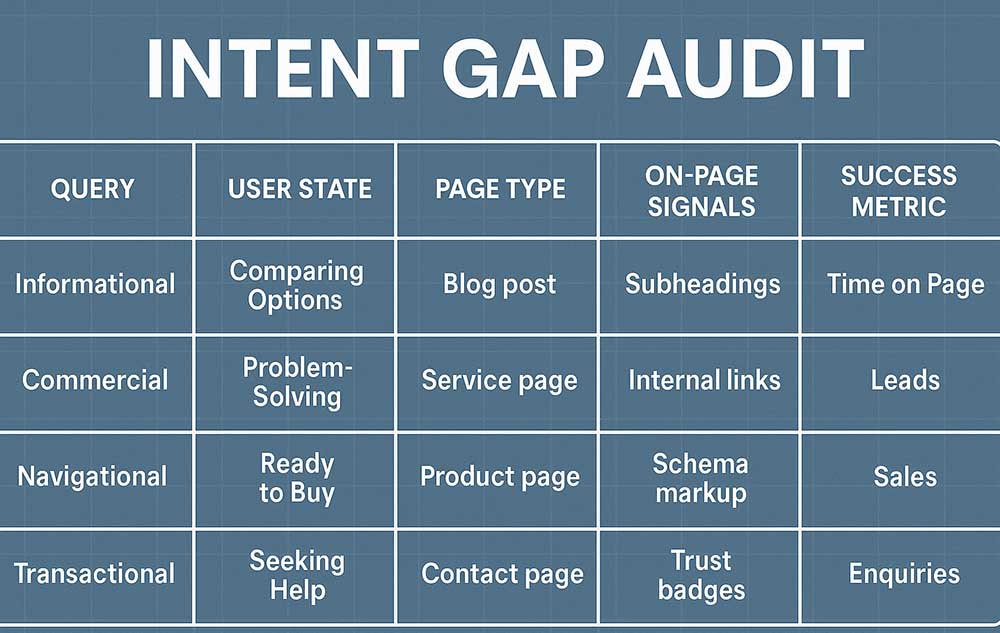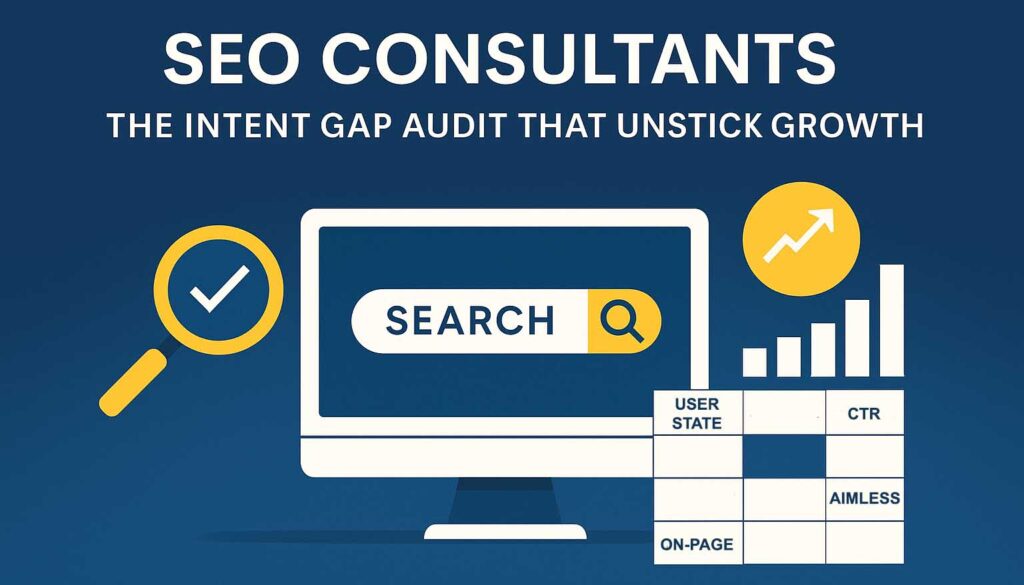A few months back, I was in a Poole café with an understandably grumpy business owner. Rankings looked lovely, impressions were up, but the phone felt quieter than it should. I pulled up their top landing pages and asked a simple question: “If I search this query, is this the page I actually wanted?” Ten minutes later, we’d circled three pages that ranked well yet answered the wrong state of mind. That gap, between what the searcher expects and what your page delivers, is where “good SEO” quietly plateaus.
I see this, not just with Bournemouth-based businesses but businesses throughout the UK: decent SEO foundations, thin results. Not a Google problem. An intent problem. As SEO consultants, our job isn’t just to win the click; it’s to match the moment the searcher is in, and guide them to the right next step.
Find the intent gap (before your pipeline does)

Ranking for “best [thing]” with a bare product grid is like walking into a showroom and being handed a credit agreement before you’ve chosen a model. People bail. I’ve had e-commerce clients who ranked on page one for strong head terms yet converted better on long-tail comparison queries. Why? Because the long-tail pages matched mindset: side-by-side options, “who it suits,” FAQs, and a nudge to buy once doubts were cleared.
When I review underperformers, I map four clues:
- SERP mix: Are Google’s results mainly guides, category lists, local packs, or service pages?
- Query language: “best/compare/how” screams research; “buy/price/near me” screams transact.
- On-page cues: Do your H2s, visuals, and CTAs match that searcher’s mood?
- Conversion friction: Is there enough proof (pricing hints, testimonials, delivery info, local creds) to move them?
The Intent Gap Matrix (use it to redesign a page, fast)
| Query | User State | Page Type Needed | On-Page Signals | Success Metric | Check After |
| “best running shoes for flat feet” | Research/compare | Guide/round-up | Model list, pros/cons, sizing tips, FAQ | Scroll depth, time on page | 30 days |
| “buy oak dining table Bournemouth” | Ready to act | Category/product (localised) | Local modifiers, stock info, delivery, CTA | Add-to-basket, calls | 14 days |
| “SEO consultants Poole” | Supplier evaluation | Service page | Case snippet, pricing cue, FAQs, CTA | Enquiries, call clicks | 21 days |
| “fix slow WordPress” | Problem solving | How-to + soft service pitch | Steps, diagnostic table, “need help?” CTA | Assisted conversions | 30 days |
How I use it: we choose the right page shape first, then optimise. If the SERP is 80% guides and your page is a product grid, you’re rowing against the tide.
Reshape a page to match intent (what I change in the wild)
1) Keyword & entity mapping
I group terms by intent buckets, not just volume. That’s the heart of our Keyword Research: cluster the “how/compare/best” queries away from the “buy/near me/price” ones, then give each cluster its own page pattern.
2) Content structure that answers doubts
Most pages are close, they’re just missing the bits people need to move. In our Content Optimisation work, I’ll add a compact comparison block and clarify benefits or process steps. FAQs aren’t for padding; they’re for objection handling.
3) Conversion shaping, not just CTAs
In Conversion Optimisation, we bring proof above the fold: a single review line, a quick “how it works,” a visible phone number. On one Bournemouth service page, we didn’t change a ranking; we changed the first 200 words and the primary CTA. Enquiries followed because the story matched the searcher’s moment.
4) Competitor reality check
Run a quick Competitor Analysis. If everyone else’s “best X” post provides pricing guidance and yours avoids it, you’ll win clicks but lose confidence. Match the minimum proof bar; then exceed it with real client evidence.
5) Data keeps you honest
Our Data-Driven Optimisation focuses on two sets of metrics: are people engaging more (scroll, time on page), and are more of them converting (calls, forms, baskets)? If neither moves, we haven’t truly closed the gap.
Book a free SEO audit
If rankings look fine but leads are flat, our SEO consultants in Bournemouth, Poole and Dorset will map your intent gaps and show the quickest fixes.
Contact Digital HypeField notes: three quick fixes that beat “more links”
- Poole trades firm: ranked for “emergency [service] near me,” but the page buried the phone number. We moved it to the top-right, added “arrival window” copy and a short trust badge row. Calls rose, not because of SEO magic, but because anxiety dropped.
- Dorset retailer: a “best [product]” guide with no real choices. We added a simple table (good/better/best), one-line pros/cons, and stocked items got a Buy now nudge. The guide finally sent traffic, rather than hoarding it.
- Bournemouth B2B: high impressions, low enquiries. The hero promised everything; the sub-copy promised nothing. We rewrote the first paragraph to answer “Why us?” in 30 words, then a 3-step process. Confidence beats copy length.
Shape an answer block for AI & the SERP
I don’t chase links when a page shape is wrong. I make the answer clearer. For research queries, a concise definition and a 3-step method often wins featured snippets and helps AI systems summarise you accurately. For transactional queries, structured product data, local cues, and clean image metadata matter — see our Image Optimisation if your media is slowing pages and costing clicks.
What to do this week
- List your top 10 landing pages by organic traffic.
- For each, note dominant SERP type (guide, category, local, service).
- If page type doesn’t match the SERP, reshape the template (guide vs category vs service).
- Add one objection-busting element above the fold (process, pricing cue, testimonial).
- Insert a compact comparison block on at least one research page.
- Re-write the first 150 words to mirror the searcher’s state of mind.
- Measure scroll depth + conversions for 30 days.
- If nothing moves, pick the next likely friction (speed, layout, proof) and iterate.
Smart FAQ: how intent alignment actually moves numbers
Why do some high-ranking pages fail to convert?
Because they answer the wrong moment, research intent landing on a sales page, or vice versa.
What to do: Match page type to SERP, then refine the above-the-fold proof.
Metric to watch: conversion rate and assisted conversions.
How do I tell if a keyword has mixed intent?
The SERP will show you a blend of guides, categories and local packs.
What to do: split into dedicated pages (guide vs category vs service).
Metric to watch: CTR per page type.
Where should FAQs live — on guides or service pages?
Wherever doubts stall action, guides need buying clarity; services need process and risk-reversal.
What to do: add 4–6 real questions customers ask.
Metric to watch: GSC impressions for FAQ snippets.
Do I need pricing on the page?
You need a pricing cue at a minimum, even if exact figures vary.
What to do: show ranges, typical scopes, or “from £X”.
Metric to watch: enquiry rate after adding cues.
Will more content fix an intent gap?
Only if it’s the right content, more words don’t mean more trust.
What to do: add comparisons, proof and process, not padding.
Metric to watch: scroll to key sections and CTA clicks.
How often should I re-audit intent?
Quarterly, or after significant ranking shifts.
What to do: re-sample SERPs, refresh page shape and proof.
Metric to watch: stability of enquiries vs rank movement.
Close the gap and measure the change
If your dashboards say “doing fine” but your diary doesn’t, you’ve got an intent gap. Close it with the right page shape, clearer proof, and a CTA that respects the moment the visitor is in. Then measure like an adult.
👉 Book a free SEO audit — I’ll show you which three pages to reshape first and how to prove it worked.


